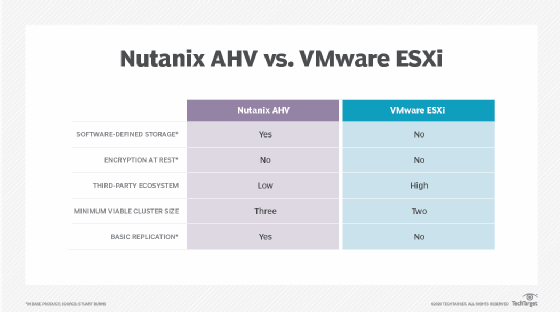Compare Nutanix AHV vs. VMware ESXi in the hypervisor battle
Though Nutanix AHV and VMware ESXi offer similar feature sets, admins' decisions will depend on several factors, such as virtualization needs and workload size.
Nutanix AHV and VMware ESXi are top-tier hypervisors that each have positives and negatives. Both are mature enterprise stacks that have everything IT administrators would expect of an enterprise class offering.
Choosing between Nutanix AHV and VMware ESXi hypervisors comes down to what admins are looking to achieve and at what cost.
What is Nutanix AHV?
Nutanix AHV is a bare-metal hypervisor that the Nutanix platform is based on. It works with other AHV hosts to provide hyperconverged storage, acting as a single-vendor stack that includes everything required for a virtualized environment. AHV has proven particularly effective in branch office use.
A lot of components in the AHV hypervisor are open source, but it's the Nutanix secret source that holds it all together.
Pros of AHV
One of the main advantages of Nutanix AHV is that it's a single unified software stack that provides virtualization functionality with software-defined storage (SDS).
Simplified management also makes AHV compelling. As an example, expanding an AHV-based cluster is straightforward, even for novice admins.
Cons of AHV
Nutanix AHV is limited in terms of additional supported hardware. For example, AHV can't support external disk arrays or Internet Small iSCSI infrastructure. Some of the more advanced tools in AHV lack the tested "just works" nature of similar tools in ESXi.
Compared to ESXi, Nutanix AHV is a relative newcomer to the hypervisor space, with far fewer customers. This means there are fewer third-party products that work with AHV available, and new products are more likely to offer support for ESXi first due to the size of the customer base.
What is VMware ESXi?
VMware ESXi is a bare-metal hypervisor that is the foundation for all VMware tools and applications, including vCenter, vSAN and customer self-service. It's the most commonly used bare-metal hypervisor.
Pros of ESXi
VMware ESXi has several advantages, including that it's been used in production environments for many years. It has a mature ecosystem that's well understood and documented. Most admins have been exposed to VMware ESXi at some point in their career.
From a hardware perspective, ESXi can be used in a hyperconverged infrastructure (HCI) configuration when paired with vSAN and additional ESXi nodes. ESXi can support external SAN systems and iSCSI out of the box and provides a wide breadth of storage and other hardware possibilities.
Cons of ESXi
Licensing and pricing have fluctuated a lot following Broadcom's acquisition of VMware. For example, perpetual VMware licenses can no longer be purchased.
Nutanix doesn't offer a perpetual license either, but they do have a more flexible range of offerings. Forced bundling, whereby users must purchase bundles including unwanted software to get the features they need, is also somewhat common for ESXi customers.

Differences between AHV and ESXi hypervisors
There are many differences between Nutanix AHV and VMware ESXi to consider, from licensing and pricing to integration, compatibility and management.
Licensing and pricing
All new and renewal licenses for VMware ESXi are subscription only. In addition, licensing has moved exclusively to a per-core model. VMware also no longer offers the free but functionality-limited ESXi version.
AHV is free, although the AHV community offering has its limitations. Note that we're talking purely about single hypervisor instances, not additional functionality, add-ons or SDS.
AHV has its own licensing issues to consider. Being tied into a proprietary ecosystem means that expanding disk arrays not only includes the cost of physical hardware but also additional storage for the SDS infrastructure. Other features, such as full disk encryption, come with additional costs.
Integration and compatibility
Without a doubt, VMware ESXi is the gold standard platform as far as integration and compatibility is concerned. There is a thriving ecosystem of add-ons for ESXi, including management, backup capabilities and automation.
AHV, on the other hand, has a small array of ecosystem add-ons. Given the way the entire stack is tightly controlled by Nutanix, there is a distinct lack of third-party vendor software options.
One example, from personal experience, is the VM disaster recovery (DR) software Zerto. It works with ESXi and Hyper-V but not AHV. This means that anyone migrating from VMware to AHV must select different DR software, and they might have fewer options to choose from.
Both companies have a supported third-party hardware list, but VMware has a huge market lead, and the list of supported hardware is larger. External storage also isn't an option with Nutanix.
It all comes down to what admins are looking to achieve and at what cost.
VMware ESXi has been around for a long time and supports a wide variety of configurations and technologies. On the other hand, Nutanix AHV differs in its additional requirements and proprietary HCI technologies.
Admins' workloads and specific virtualization needs will help determine which hypervisor better suits their systems.
Management
Management of the two hypervisors is what sets them apart. As standalone hypervisors, their management is quite trivial. Where they differ is when building a cluster of machines with the management GUIs designed for these hypervisors. VMware ESXi is commonly managed through vCenter, while Nutanix customers typically use Prism.
As an example, when using shared storage in VMware, admins must include the time to configure storage networking, create storage and present it over the network to each of the hosts. All the storage is rescanned at that point and must be verified on each host.
Nutanix uses a simple wizard that enables the creation of a storage pool. There's no additional hardware to consider. Using storage under VMware requires a lot more upfront setup. VMware vSAN is an option, but it isn't natively baked in, so there are additional system management setup steps.
Using VMware in an HCI environment introduces more complexity, especially around cluster-wide upgrades and updates and how they are managed compared to non-HCI storage. At the same time, there's the cost of vSAN. Features such as deduplication, compression and data at rest encryption don't come in the base version.
However, the range and type of storage available in a non-HCI environment is much wider and trades simplicity for features and advanced setups.
Each AHV hypervisor has a management or controller VM to manage storage replication. Each one consumes 32 GB of RAM, so a six-node cluster would consume 192 GB of RAM.
The number of nodes is also important for several reasons. With SDS, only a specific number of hosts can be down at any one time. Lose too many hosts and the SDS stops working. Cluster-based HCI upgrades can take a significant amount of time. Because of the way data is striped across the cluster, only a small number of nodes can be upgraded concurrently.
Upgrading larger clusters using AHV's built-in tools can take a long time. In some cases, clusters get so large that admins can't upgrade them within a working weekend.
In short, HCI platforms such as Nutanix have a smaller management overhead. But there are significant management considerations, higher initial costs and potential for vendor lock-in.
Choosing between the two
When comparing Nutanix and VMware hypervisors, admins must determine which feature sets and capabilities better suit their workloads. For example, Nutanix AHV is an HCI-only offering, meaning admins can't add external storage forms other than Network File System and iSCSI.
Workloads that require additional hardware, such as Fibre Channel cards, won't function if the workload relies on AHV. There is little point considering AHV if admins are keeping their SAN infrastructure because AHV's standalone clusters don't allow for outside hardware dependencies.
Out of the box, AHV and ESXi feature sets are similar. VMware strips down ESXi to two vCenter offerings and Nutanix offers three through AHV. Nutanix AHV enables automated workload management across clusters no matter which version of AHV admins use. With VMware, this feature is only available in vSphere ESXi once admins purchase vCenter. Manual management is still available but not as efficient.
As mentioned earlier, Nutanix doesn't provide data deduplication and compression with AHV unless admins purchase an advanced license rather than the standard license. Both are critical to achieving optimal storage savings. The standard license also limits how many nodes can participate in a cluster. Similarly, the ESXi hypervisor doesn't come with built-in vSAN, which admins can purchase as an add-on.
Both AHV and vSAN require upgraded licenses to support data encryption at rest, which is essential for many companies given the ever-changing personally identifiable information landscape.
The decision between Nutanix and VMware isn't a straightforward choice. It all comes down to what admins are trying to achieve. If there are highly trained admins in an existing vSphere ESXi environment, then staying with VMware is a safe bet, especially if there are third-party tools that interface with ESXi or vSphere. Both AHV and ESXi can accomplish many of the same tasks, but admins' workload requirements will weigh heavily on their final decision.
Stuart Burns is a virtualization expert at a Fortune 500 company. He specializes in VMware and system integration with additional expertise in disaster recovery and systems management. Burns received vExpert status in 2015.







